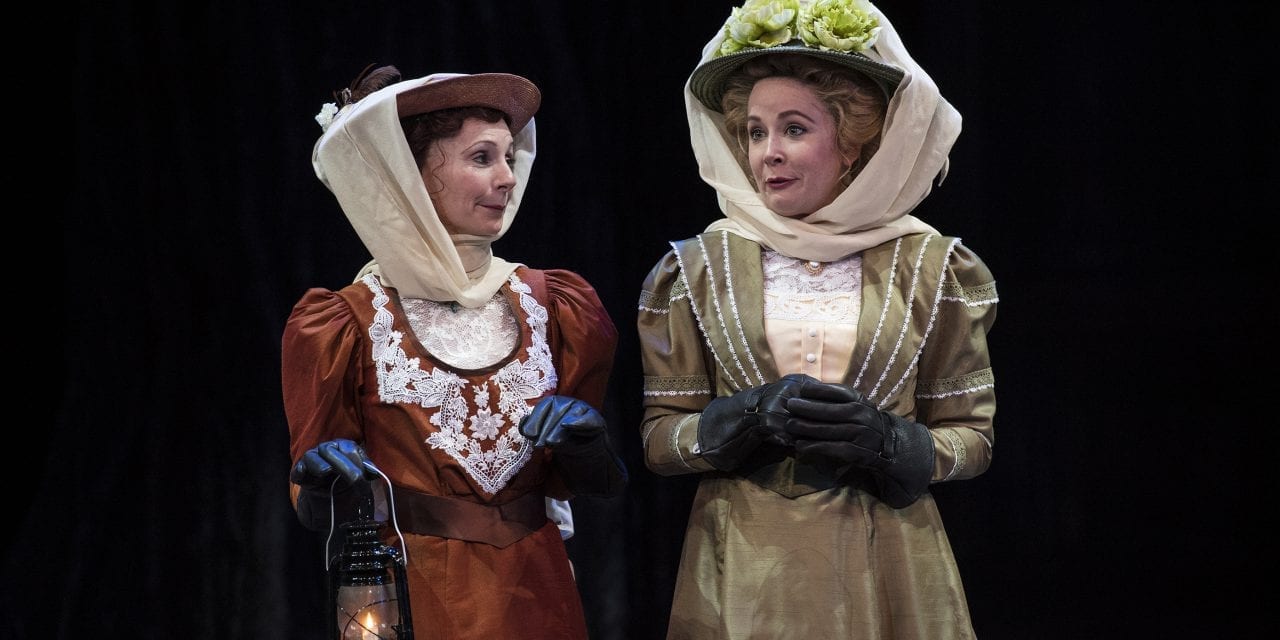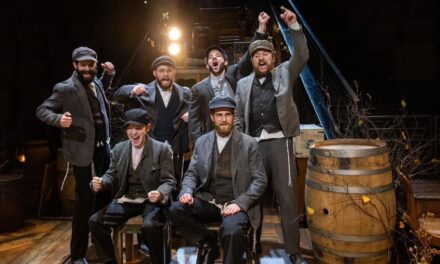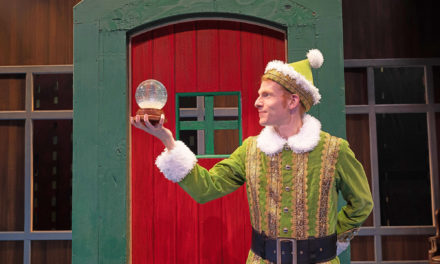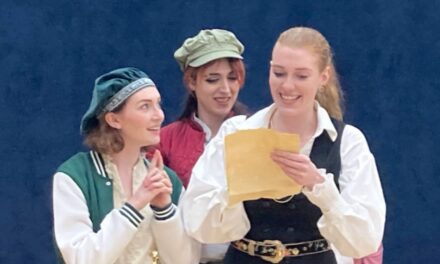CEDAR CITY — The Merry Wives of Windsor is known as Shakespeare’s foray into domestic comedy. Taking his beloved Falstaff character and transporting him to the contemporary countryside, this play is Shakespeare’s only glimpse at the Elizabethan era’s middle class. The Utah Shakespeare Festival has a production that moves the action to early 1900’s England, with disappointing results.

Show closes September 8, 2018.
The Merry Wives of Windsor tells the story of Sir John Falstaff’s attempts to form a relationship with two married women: Mistress Page and Mistress Ford. He sends them nearly identical love letters, but the two neighbors share the letters with one another and are furious at Falstaff for his presumptuousness. They decide to trick the old lecher into pursuing the relationships and, in the process, make a fool out of him. Meanwhile, Mistress Page has a daughter, Ann Page (Cailen Fu), who loves the dashing Fenton (played by Ty Fanning), but her father and mother each have a different man that they would prefer her to marry.
Director Paul Mason Barnes chose to set The Merry Wives of Windsor at the turn of the twentieth century. One of the main techniques for establishing this setting was the use of period music, mostly Scott Joplin’s “Bethena” and Edward Madden’s “Moonlight Bay,” but also “Daisy, Daisy,” and Joplin’s “The Cascades” and “The Entertainer.” While music director Brandon Scott Grayson‘s arrangements were lovely, they did little more than lengthen the duration of scene changes. New music and lyrics were also composed for a few of the scenes (such as the scene where Falstaff is accosted in the forest), but these never added to the show, and often distracted from the script.

John Ahlin (left) as Sir John Falstaff and Stephanie Lambourn as Mistress Margaret Page. (Photo by Karl Hugh. Copyright Utah Shakespeare Festival 2018.)
Not only did Barnes’s directorial vision add a great deal of music to the play, but he also added text to the script. While Shakespeare’s works are not sacred canon, the modern language and distinctly non-Shakespearean additions (e.g., having characters introduce themselves at the beginning of the play) did not integrate well with the script. I also found it annoying that sometimes characters announced the location of a scene just before it started. This was especially grating at the Garter Inn, where a large sign upstage already said, “The Garter Inn.” Moreover, the trope was used inconsistently; there was never any pattern to why some scenes had their location announced and others did not.
That being said, the actors carried out Barnes’s vision well, and their singing was lovely. The problem is that this production is more about Barnes’s directorial ideas than it is about The Merry Wives of Windsor, and the script itself felt neglected. Some scenes dragged in their pacing (such as Master Ford’s first scene in disguise), and because of the music and physical humor that Barnes added, there was little momentum from one scene to another. In the end, I left the theater unfulilled by what I saw.
As the titular merry wives, Tarah Flanagan and Stephanie Lambourn (playing Mistress Alice Ford and Mistress Margaret Page, respectively) were delightful. I reveled in their delight as they foiled Falstaff’s efforts to create a relationship with them. The two women were best when scheming, and it was nice to see the two women playfully interact. On the other hand, I wish they had been better differentiated, with different mannerisms or more varied personalities (which would make the play easier for novices to understand). I also did not like the loud, affected way that the two characters spoke (as if the two characters did not know how to convincingly pretend in order to advance their scheme) when Falstaff was listening to them, because it undercut Mistress Ford’s and Mistress Page’s intelligence. Like The Merchant of Venice (also currently playing at the festival), the leading female characters in The Merry Wives of Windsor are the smartest characters in the play; to make them incapable of acting normally while they execute their plan undercuts their intelligence.

John Ahlin (left) as Sir John Falstaff and Tarah Flanagan as Mistress Alice Ford. (Photo by Karl Hugh. Copyright Utah Shakespeare Festival 2018.)
Another character that was undercut in this production was Sir John Falstaff (played by John Ahlin). The entire purpose of The Merry Wives of Windsor is to give the audience a good laugh at Sir John’s expense. The character’s high self-regard and selfish actions make him a beloved character in this play and in Henry IV, Part One and Henry IV, Part Two. Ahlin has all that his roguish character mastered, and he knew how to make Falstaff look as silly as possible when he believed that he was a champion lover.
The problem in this production for Falstaff is that there were so many other cartoony, foolish characters (thanks to the physical humor that Barnes added to the show) that Falstaff lost his uniqueness and became just one more clown in a parade of clowns. The silly antics also slowed down the show and dumbed down the play excessively. (Does anyone still laugh at a spit take any more? Does anyone still laugh at three?)
The costumes (designed by Bill Black) for this production looked perfect for a summer at the turn of the twentieth century, with pastels and earth tones with accents of white (appropriate for a play that mostly performs before Labor Day). When coupled with Barnes’s changes, though, the costumes made me feel like I was watching a production of The Music Man or Ragtime, instead of a Shakespearean comedy. The set design by Apollo Mark Weaver featured beautiful white gables (symbolizing the Ford and Page homes) and a lovely blue and white staircase to the upstage balcony. Again, though, the design—in this case the steamboat painted upstage—reminded me of Show Boat or Big River (the latter currently playing at the Festival), and not the British setting of the play.
On several accounts, The Merry Wives of Windsor did not live up to the potential of the script. Had Barnes trusted that script more and stepped back and let the show work on its own terms, it could have been a success. While there are some strong points to the show, there is little in this production that leads to a satisfying Shakespeare experience.
Donate to Utah Theatre Bloggers Association today and help support theatre criticism in Utah. Our staff work hard to be an independent voice in our arts community. Currently, our goal is to pay our reviewers and editors. UTBA is a non-profit organization, and your donation is fully tax deductible.





